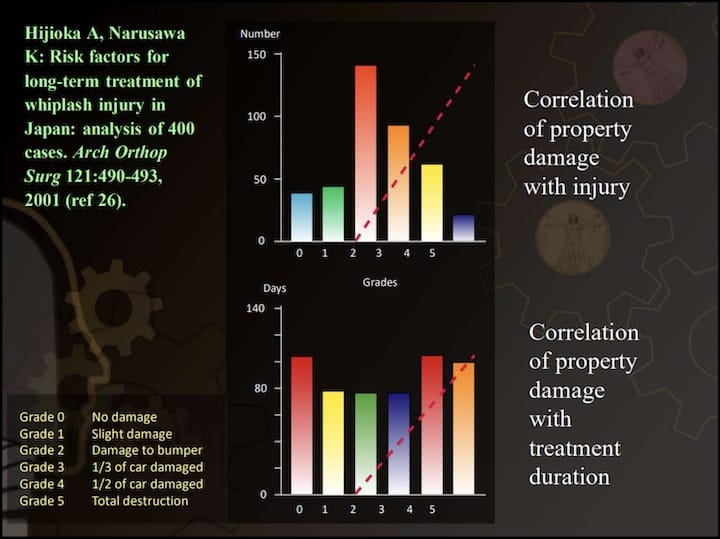There are a lot of myths related to car crashes and low-speed collisions. Often the vehicles involved have a small amount of visible damage or no visible damage at all. Some “experts” believe that an individual in a vehicle involved in a collision cannot be injured if the vehicle sustains only minimum structural damage. This is MYTH #1. And yet, there is no doubt that individuals involved in minimum structural damage collisions develop symptomatology consistent with whiplash-type neck distortion soft tissue injuries. Practicing health care providers who examine these patients routinely document findings that are consistent with soft tissue trauma.
I often use the simplest explanation to help patients understand how this can be possible by asking the question “If the car was not damaged in the collision, where did the energy go?” Just about 100% respond with “into me”. And this is the point.
With adamant claims by patients that their symptoms are genuine and by doctors that their findings are genuine, there arises the cynical perspective that the patient’s prime objective is secondary gain and that of the doctor’s is greed. This cynicism is perpetuated by the insurance company with complete disregard to the injury complaints. Claims adjusters are trained to only connect the amount of damage to the amount of injury. They are trained to equate damage and injury as a linear response. Let me illustrate from this (2001) article by Hijioka et. al.

You will see in the first graph at the top the correlation to damage of the vehicle and the number of people reporting injury. This graph has a classic inverted “U” shape. Notice the peak amount of people injured occurs when there is visible damage to the bumper. Interesting to see that “No Damage” and “Slight Damage” have more reported injuries compared to “Total Destruction”. The point is, people report injuries at a fairly significant rate with little to no visible damage to the car. Claims adjusters, however, are taught and believe that injuries are linearly related to the amount of damage as represented by the red dash line. Take note that this line starts a “zero injuries” when only damage to the bumper is visible.
The bottom graph correlates the amount of damage to a car and the amount of treatment needed. This is in the shape of an upright “U”. This means that those people with injury that need the most amount of treatment are at the ends; where “No Damage” and “Total Destruction” exist. How can it be that when a car sustains the most amount of damage, the occupant reports injuries and needs just about the same amount of treatment duration as a car that shows no signs of damage whatsoever? Again the claims adjuster will disqualify treatment in the little to no damage cases, favoring treatment only to those that can show damage to the car (as represented by the red dash line).
To understand why this happens one needs a short refresher class from our high school physics class days. This will be in the next blog post.






